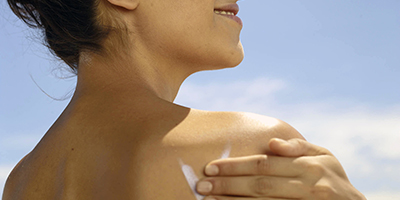Sun Protection "Musts" for the Entire Family
All sun protection is not created equal, and there are a few key terms1 to look for on the label of a sunscreen used by any member of the family. First, make sure all sunscreens have an SPF of at least 30 and says “broad spectrum” on the label. This means that the sunscreen provides protection against both “aging” UVA rays and “burning” UVB rays. If swimming or sweating, look for a “water resistant” sunscreen, and remember to apply sunscreen to often-forgotten spots such as the ears, along the hairline, the tops of the feet and the lips. (A sunscreen stick can be useful for applying sun protection to these small spots.) And most importantly, everyone needs to use sunscreen regardless of skin type or skin tone.2
Your beach bag may be stocked with baby sun protection, kids’ sunscreen and products just for the adults, but it’s important to make sunscreen part of every family member’s daily routine (and not just when spending prolonged periods of time outdoors). UVA rays can penetrate glass while driving3 to and from school or work (or anywhere else), and up to 80% of UV rays can still reach the skin on cloudy days.4


Sunscreen for Kids
Sun protection provides both short- and long-term benefits for skin health, and in addition to helping to prevent sunburn today, sunscreens (when used as directed along with other sun protection measures) can reduce accumulated sun damage5 that appears years from now. Consider these alarming statistics:
- According to the American Association for Cancer Research, five or more blistering sunburns before the age of 20 may increase melanoma risk by 80% 6
- One in five Americans will develop skin cancer by the age of 70 7
This is why sunscreen for kids8 is so important—and both mineral/physical and chemical sunscreen ingredients are FDA-approved for use in children over the age of six months. As any parent knows, it can be hard to get kids to sit still long enough to thoroughly apply sun protection, but there are a few tips for getting the little ones to comply. One is to establish good sun protection habits9 early by making sunscreen application part of everyone’s morning routine—just like tooth-brushing. In addition to sunscreen, covering up when spending time outdoors is another effective way to help protect the skin. This includes wearing a hat, sunglasses and long-sleeved shirts or rash guards when at the beach or pool.2
Baby sun protection
Babies have delicate skin that can be especially vulnerable to the damaging effects of the sun. New parents often wonder about the best sunscreen for babies, and there are several factors to keep in mind. First, many dermatologists recommend avoiding the use of sunscreen in babies younger than six months old. Instead, protect their skin by keeping them in the shade and dressing them in long sleeves, pants, wide-brimmed hats and sunglasses. After six months of age, broad spectrum, water resistant, physical- or chemical-based UV filters are also considered safe and effective for sun protection.1
- https://www.aad.org/public/spot-skin-cancer/learn-about-skin-cancer/prevent/sunscreen-labels/how-to-decode-sunscreen-lingo
- Baumann, L. (2009) Cosmetic Dermatology: Principles and Practice (pp.245-254). New York: McGraw-Hill Medical
- https://www.skincancer.org/prevention/are-you-at-risk/sun-hazards-in-your-car
- https://www.skincancer.org/healthy-lifestyle/outdoor-activities/essential-sun-safety-information-for-skiers-and-snowboarders
- https://www.webmd.com/melanoma-skin-cancer/ss/slideshow-sun-damaged-skin
- https://www.aacr.org/Newsroom/Pages/News-Release-Detail.aspx?ItemID=553
- https://www.skincancer.org/skin-cancer-information/skin-cancer-facts
- https://www.cdc.gov/cancer/skin/basic_info/children.htm
- https://www.skincancer.org/prevention/sun-protection/prevention-guidelines
https://www.webmd.com/melanoma-skin-cancer/ss/slideshow-sun-damaged-skin
